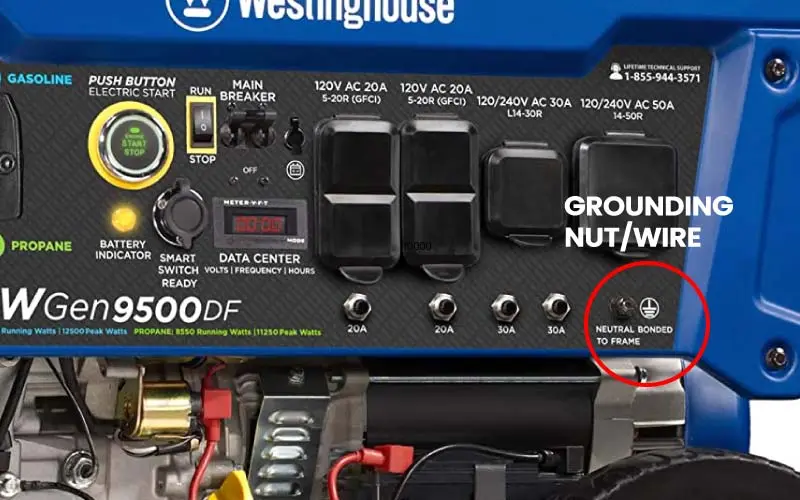How to Ground A Generator in 6 Steps Safely and Efficiently?
Proper grounding is essential for generator performance. Discover how to ground a generator safely and effectively with our step-by-step guide.
Proper grounding of a generator is a crucial safety measure that must not be overlooked by any generator owner.
Grounding ensures that the generator’s electrical system remains within safe limits, preventing dangerous electric shocks, fires, and equipment damage.
Without a proper ground connection, the generator’s metal frame and other exposed metal parts could become energized, posing a significant safety risk.
Improper Generator Grounding Incidents.
In 2018, a man was electrocuted while attempting to refuel a generator that was not properly grounded.
The generator’s metal frame had become energized with electricity, and when the man touched it, he received a fatal electric shock.
In another incident in 2017, a house fire was started by an ungrounded generator that had been left running in a garage.
The generator had been used to power the house during a power outage, but without proper grounding, it caused a voltage surge that sparked the fire.
These incidents serve as a reminder of the importance of proper grounding when using a generator, and the potentially serious consequences of failing to do so.
That’s why we’re here to help! As generator experts, we’ve seen all kinds of grounding problems and have the know-how to guide you through the process.
In this article, we’ll show you the step-by-step process for grounding your generator, as well as offer some tips and tricks for making the process easier.
So let’s get started and make sure your generator is grounded properly for safe and efficient operation! Check out these other generator safety tips as well while you are at it.
What is Generator Grounding?
Generator grounding refers to the process of creating a direct electrical connection between the generator and the earth. Or, it is a connection of an electrical circuit with a reference ground.
This is typically done by connecting a grounding wire or rod to the generator’s metal frame and driving it into the ground.
The purpose of grounding is to create a low-resistance path for electrical current to flow to the earth in the event of a fault or short circuit.
This helps to prevent dangerous electrical shocks and fires by redirecting excess electrical energy away from people and equipment.
Grounding also helps to stabilize the generator’s voltage and protect electronic equipment from damage due to voltage spikes or surges. Proper generator grounding is a critical safety measure that should be taken seriously by all generator owners. We also got an article if you want to polarize a generator during ground,
Tools Required For Generator Grounding
How to Ground a Generator in 6 Steps
Step 1: Choose a Grounding Method
There are two main methods for grounding a generator. Grounding to a grounding copper rod or grounding to an existing grounding system.
If you’re unsure which method is appropriate for your generator, consult the manufacturer’s instructions or a qualified electrician.
Step 2: Prepare the Grounding Copper Rod
You’ll need to prepare it by removing any rust, paint, or other coatings from the top 6 inches of the rod. This ensures a good connection between the rod and the ground.
Step 3: Drive the Grounding Copper Rod
Using a hammer or mallet, drive the grounding rod into the ground at a depth of at least 8 feet. If the soil is rocky or hard, you may need to use a grounding rod driver or hire a professional to install the rod. Read this research about improper grounding and how potential risks involved in it.
The more you drive the rod in the ground, the better. It will ensure proper Earth. Pour some water on the surface if it is too hard to work on. Make sure the installation angle doesn’t exceed 45°.
Step 4: Connect the Wire to Copper Rod

Strip the copper wire using a wire stripper. Be careful, only strip a certain length of wire that is going to be attached to the grounding wire. The additional bare wire will increase the chances of electrocution. Wrap the wire around the grounding rod.
Step 5: Check the Resistance with Multimeter
Check the electrical resistance between the generator frame and the ground.
The resistance should be less than 5 ohms to ensure a proper grounding connection. If the resistance is higher than 5 ohms, adjust the grounding rod depth or position, or clean any rust or paint from the grounding connection points.
Step 6: Test the Generator
There is a bolt in the generator that is specifically used for grounding purposes. Use a wrench to loosen the bolt. Wrap around the wire then tighten it up.
After grounding the generator, test it to ensure that it’s operating correctly. Check the voltage output and run a load test to make sure that the generator is functioning properly.
By following these steps, you can properly ground your generator and ensure safe and reliable operation. Remember to always consult the manufacturer’s instructions and follow all local electrical codes when working with generators and electrical systems. Proper grounding is an essential safety measure that should not be overlooked.
Why Is Generator Grounding Important?
Generator grounding is important for safety reasons. Grounding helps to protect people and equipment from electric shocks and other hazards that could occur if a fault or short circuit occurs. It also helps to prevent damage to electrical equipment and reduces the risk of fires. Osha (Occupational Health and safety) also has written a safety guide about grounding.
What Happens If You Don’t Ground A Generator?
If a generator is not grounded, it can pose serious safety risks for people and equipment connected to it. Grounding is a critical safety feature that helps protect against electric shocks and other hazards. Grounding is more important if you are going to connect the generator to a house using a transfer switch.
When a generator is not grounded, there is a risk of electrical shock, especially if a fault or short circuit occurs.
A ground fault occurs when an electrical conductor comes into contact with a grounded surface, creating a path of low resistance for electrical current to flow through.
Without proper grounding, the current will seek out other paths to ground, which could include people or equipment in contact with the generator or its electrical circuit.
Additionally, an ungrounded generator can cause damage to electrical equipment or even start a fire. This is because a ground fault can cause an overload in the electrical system, which can lead to overheating and potentially start a fire.
Therefore, it’s critical to follow proper grounding procedures for generators to ensure the safety of people and equipment connected to them.
I would 100% recommended to consult with a qualified electrician or referring to the generator’s user manual for specific grounding instructions if you are tech-savvy like me.
You don’t have to be all smart and mess with electricity. Seek professional help if it is needed.
Thanks for reading my article. I hope you liked it.
Frequently Asked Questions (FAQs)
What Is Generator Grounding?
Generator grounding is the process of connecting the frame or enclosure of a generator to the earth through a grounding conductor. This is done to protect against electrocution and other hazards that could occur if a fault or short circuit occurs.
How Do I Ground a Generator?
To ground a generator, you need to connect the metal frame or enclosure of the generator to the earth using a grounding conductor. The grounding conductor should be connected to a grounding copper rod that is buried in the ground. It’s recommended to consult with a qualified electrician or refer to the generator’s user manual for specific grounding instructions.
What Are the Types of Generator Grounding?
There are two types of generator grounding: system grounding and equipment grounding. System grounding involves connecting the neutral point of the generator to the earth, while equipment grounding involves connecting the metal frame or enclosure of the generator to the earth.
What Are the Consequences of Not Grounding a Generator?
If a generator is not grounded, it can pose serious safety risks for people and equipment connected to it. Without proper grounding, there is a risk of electrical shock, equipment damage, and fire hazards.

Fareed, the highly skilled electrical expert, boasts 5 years of extensive experience in proficiently maintaining, repairing, diagnosing, and installing a diverse range of electrical systems.
